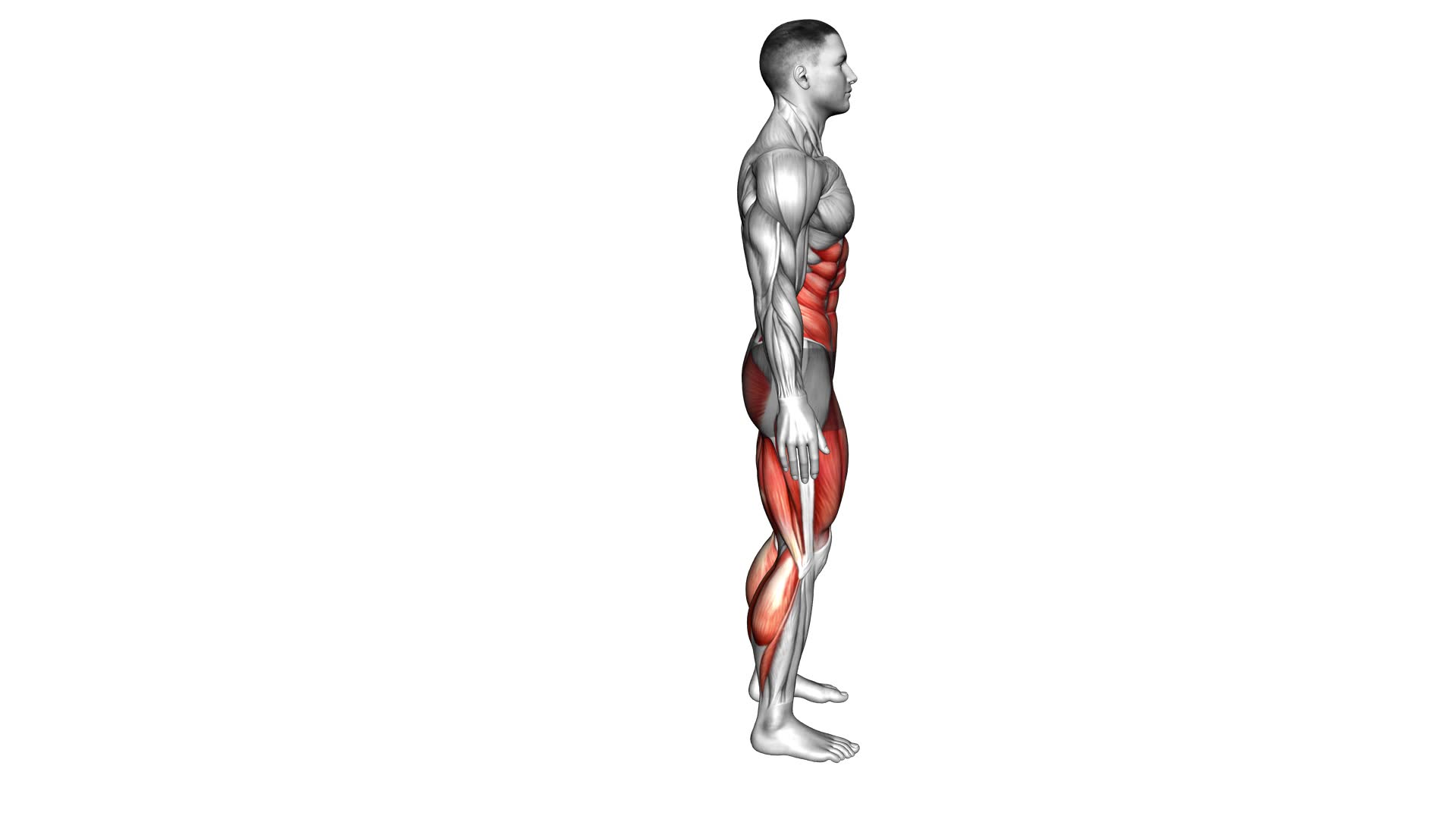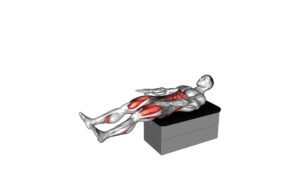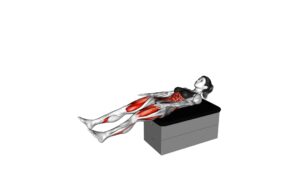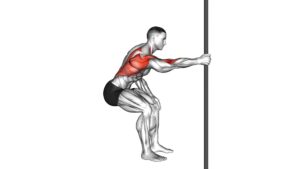Fixed Feet Sit-Up Stand (male) – Video Exercise Guide & Tips

Are you ready to take your core workout to the next level? Look no further than the fixed feet sit-up stand!
Watch This Exercise Video
This exercise targets your abs and strengthens your core like no other. In this video exercise guide, we'll show you the proper form and technique, common mistakes to avoid, and advanced variations to challenge yourself.
Get ready to feel the burn and get the results you've been craving. Let's get started!
Key Takeaways
- The fixed feet sit-up stand routine targets abs and strengthens the core.
- Proper form and technique, including engaging the core muscles and avoiding strain on the lower back, are important for optimal results and to reduce the risk of injuries.
- Core engagement is crucial for stabilizing the spine, improving overall stability and posture, and preventing excessive strain on the lower back.
- To ensure an effective workout and maintain safety, it is recommended to add resistance or perform advanced variations, set realistic goals, warm up before starting, listen to your body, and use a stable and sturdy sit-up stand.
Benefits of the Fixed Feet Sit-Up Stand
You can strengthen your core muscles by performing the Fixed Feet Sit-Up Stand exercise. This exercise is highly effective for improving posture and increasing abdominal strength.
By targeting the core muscles, including the rectus abdominis and obliques, the Fixed Feet Sit-Up Stand helps to stabilize the spine and maintain proper alignment. As a result, it can help correct poor posture and reduce the risk of back pain.
Additionally, the exercise engages the abdominal muscles, leading to increased strength and definition in this area. Stronger abdominal muscles not only contribute to a toned physique but also provide better support for the lower back and improve overall core stability.
To reap the full benefits of the Fixed Feet Sit-Up Stand, it's important to maintain proper form and technique. This will ensure that you engage the correct muscles and avoid strain or injury.
Proper Form and Technique
To perform the fixed feet sit-up stand with proper form and technique, it's crucial to engage your core muscles throughout the exercise. This will help you maintain stability and prevent strain on your lower back.
Core Engagement Importance
Achieving proper form and technique during the Fixed Feet Sit-Up Stand exercise requires a strong focus on engaging your core muscles. Core activation is essential for this exercise as it helps to stabilize your spine and maintain a proper alignment throughout the movement. By actively contracting your abdominal muscles, you can effectively target and strengthen your core, improving overall stability and posture.
Engaging your core also helps to prevent excessive strain on your lower back, ensuring a safe and effective workout. However, it's important to note that proper form and technique alone aren't enough to avoid back strain. In the next section, we'll discuss additional tips on how to avoid putting excessive stress on your back during this exercise.
Avoiding Back Strain
To avoid back strain during the Fixed Feet Sit-Up Stand exercise, focus on maintaining proper form and technique while engaging your core muscles. This won't only prevent injuries but also strengthen your abdominal muscles.
Start by lying on your back with your knees bent and feet flat on the ground. Place your hands behind your head, keeping your elbows out to the sides.
As you lift your upper body off the ground, exhale and engage your core muscles, ensuring that your lower back stays in contact with the floor. Avoid pulling on your neck or using momentum to lift yourself up.
Slowly lower back down to the starting position and repeat the movement, keeping your focus on your core engagement throughout the exercise.
Common Mistakes to Avoid
When performing the fixed feet sit-up stand, it's important to be aware of common mistakes that can compromise your form and effectiveness.
One common mistake to avoid is improper form, which can lead to strain on your neck and lower back.
Another mistake is lack of core engagement, where you rely too much on your hip flexors instead of using your abdominal muscles.
Improper Form Dangers
Avoid these common mistakes in order to maintain proper form and prevent potential dangers while performing the Fixed Feet Sit-Up Stand exercise. Incorrect form can lead to various risks and increase the chances of injury.
Firstly, avoid using momentum to complete the movement. Jerking or swinging your body can strain your back and neck muscles.
Secondly, don't hold your breath during the exercise. This can increase blood pressure and cause dizziness or fainting. It's important to breathe in and out steadily throughout the movement.
Lastly, don't strain your neck by pulling on it with your hands. Instead, focus on engaging your core muscles and using them to lift your upper body.
Lack of Core Engagement
By failing to engage your core muscles, you risk compromising the effectiveness and safety of the Fixed Feet Sit-Up Stand exercise. Core engagement is crucial for maintaining stability and promoting proper form during this exercise.
Without activating your core muscles, you may put unnecessary strain on your lower back and increase the risk of injury. The core muscles, including the abdominals, play a significant role in stabilizing the spine and supporting your body during movements.
To ensure proper core engagement, focus on contracting your abdominal muscles throughout the exercise. This will help maintain a stable and supported spine, allowing you to perform the Fixed Feet Sit-Up Stand with improved efficiency and reduced risk of injury.
Advanced Variations and Modifications
To challenge yourself further with the fixed feet sit-up stand exercise, try incorporating advanced variations and modifications. These advanced modifications will help you take your core workout to the next level and continue to build strength and endurance.
One advanced variation you can try is adding resistance by holding a weight plate or medicine ball against your chest as you perform the sit-up. This will increase the intensity of the exercise and engage your core muscles even more.
Another modification you can try is performing the sit-up on an unstable surface, such as a stability ball or a Bosu ball. This will require your core muscles to work harder to stabilize your body during the movement.
Proper technique guidance is crucial when incorporating advanced variations and modifications. Make sure to maintain proper form throughout the exercise and focus on engaging your core muscles. It's also important to start with a weight that challenges you but still allows you to maintain proper form. Gradually increase the weight or difficulty level as you become stronger and more comfortable with the exercise.
By incorporating advanced variations and modifications into your fixed feet sit-up stand routine, you can continue to challenge your core muscles and see progress in your strength and endurance.
Now, let's move on to the next section for some tips on how to get the most out of your workout.
Tips for Getting the Most Out of Your Workout
Are you wondering how you can maximize the effectiveness of your workout and get the most out of your fixed feet sit-up stand routine? Getting started and staying motivated are key factors in achieving your fitness goals. Here are some tips to help you get the most out of your workout:
- Set realistic goals: Before starting your fixed feet sit-up stand routine, set realistic goals that are specific, measurable, attainable, relevant, and time-bound (SMART). This will give you a clear direction and keep you motivated.
- Warm up properly: Prior to engaging in any exercise, it's important to warm up your muscles to prevent injuries. Spend a few minutes doing light cardio exercises like jogging or jumping jacks to get your blood flowing and prepare your body for the workout.
- Maintain proper form: Focus on maintaining proper form throughout your fixed feet sit-up stand routine. This won't only maximize the effectiveness of the exercise but also prevent injuries. Keep your core engaged, your back straight, and your feet firmly planted on the ground.
- Stay consistent: Consistency is key when it comes to any workout routine. Make a schedule and stick to it. Even if you can only spare a few minutes each day, staying consistent will yield better results than sporadic, intense workouts.
- Stay motivated: Find ways to stay motivated, such as listening to energizing music, working out with a friend, or rewarding yourself after achieving milestones. Remember why you started and keep that in mind as you progress towards your fitness goals.
Safety Precautions and Considerations
When performing the fixed feet sit-up stand routine, it's important to prioritize safety and consider certain precautions to avoid potential injuries. One key aspect of preventing injuries is proper equipment usage. Make sure to use a stable and sturdy sit-up stand that can support your body weight. Check for any loose or damaged parts before starting your workout. Additionally, it's crucial to position your feet correctly on the footrests to maintain stability and prevent any slips or falls. Keep your feet firmly planted throughout the exercise to ensure a safe and controlled movement.
Another safety consideration is to avoid straining your neck and back. Engage your core muscles and use them to lift your upper body rather than relying solely on your neck muscles. This will help distribute the workload evenly and reduce the risk of strain or injury. It's also important to maintain proper form throughout the exercise. Avoid jerky or sudden movements, and focus on a smooth and controlled motion.
Lastly, listen to your body and know your limits. Start with a comfortable number of repetitions and gradually increase intensity as you become more comfortable and stronger. If you experience any pain or discomfort, stop the exercise immediately and consult a healthcare professional. Remember, safety should always be your top priority to ensure a successful and injury-free workout.
Frequently Asked Questions
Can the Fixed Feet Sit-Up Stand Be Used by People With Lower Back Pain or Injuries?
If you're dealing with lower back pain or injuries, you might be wondering if the fixed feet sit-up stand is suitable for you. Using this exercise equipment can help strengthen your core muscles, which can potentially provide relief for lower back pain.
However, it's important to consult with a healthcare professional or a trainer to ensure that this exercise is safe and appropriate for your specific condition. They can guide you in choosing the best exercises for lower back pain relief.
How Many Repetitions Should I Aim for When Performing the Fixed Feet Sit-Up Stand?
When performing the fixed feet sit-up stand, it's important to consider your fitness level and any lower back pain or injuries you may have. As for the number of repetitions, it's recommended to start with a lower number, such as 8-10, and gradually increase as you get stronger.
However, if you have lower back pain, it's advisable to consult with a professional or modify the exercise to avoid exacerbating your condition.
Is It Necessary to Use Additional Weights or Resistance While Doing This Exercise?
When doing the fixed feet sit-up stand, it's not necessary to use additional weights or resistance.
However, if you want to challenge yourself and increase the intensity of the exercise, you can try using alternative exercises like weighted sit-ups or Russian twists. These exercises will engage your core muscles even more.
Beginners can start with modified versions of the fixed feet sit-up stand, such as bent-knee sit-ups or assisted sit-ups using a stability ball.
Can the Fixed Feet Sit-Up Stand Help in Achieving Six-Pack Abs?
Yes, the fixed feet sit-up stand can help in achieving six-pack abs. It's a great exercise for strengthening your core muscles and building abdominal strength.
Beginners can definitely do this exercise as it doesn't require any additional weights or resistance. It can also be modified for different fitness levels by adjusting the difficulty level and range of motion.
Remember to maintain proper form and gradually increase the intensity to see the best results.
Are There Any Specific Dietary Recommendations or Guidelines to Follow When Incorporating the Fixed Feet Sit-Up Stand Into My Fitness Routine?
When incorporating the fixed feet sit-up stand into your fitness routine, it's important to consider dietary recommendations.
To achieve your desired results, focus on a balanced diet that includes lean proteins, healthy fats, and complex carbohydrates. Aim to consume enough calories to fuel your workouts and support muscle growth.
Hydration is also key, so be sure to drink plenty of water throughout the day.
Conclusion
In conclusion, the fixed feet sit-up stand is a beneficial exercise for strengthening the core muscles. By maintaining proper form and technique, you can maximize the effectiveness of this exercise and avoid common mistakes.
Advanced variations and modifications can be incorporated to challenge yourself further. Remember to follow safety precautions and consider your fitness level before attempting this exercise.
With consistency and proper guidance, you can achieve great results from incorporating the fixed feet sit-up stand into your workout routine.

Author
Years ago, the spark of my life’s passion ignited in my mind the moment I stepped into the local gym for the first time. The inaugural bead of perspiration, the initial endeavor, the very first surge of endorphins, and a sense of pride that washed over me post-workout marked the beginning of my deep-seated interest in strength sports, fitness, and sports nutrition. This very curiosity blossomed rapidly into a profound fascination, propelling me to earn a Master’s degree in Physical Education from the Academy of Physical Education in Krakow, followed by a Sports Manager diploma from the Jagiellonian University. My journey of growth led me to gain more specialized qualifications, such as being a certified personal trainer with a focus on sports dietetics, a lifeguard, and an instructor for wellness and corrective gymnastics. Theoretical knowledge paired seamlessly with practical experience, reinforcing my belief that the transformation of individuals under my guidance was also a reflection of my personal growth. This belief holds true even today. Each day, I strive to push the boundaries and explore new realms. These realms gently elevate me to greater heights. The unique combination of passion for my field and the continuous quest for growth fuels my drive to break new ground.







